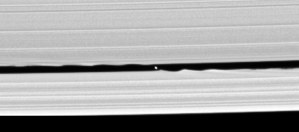More on S/ 2005 S 1: The Keeler Gap Moon (AKA the Wavemaker)

This was reported earlier from the IAU Circular, now here are some additional images
The ISS team has announced the discovery of S/ 2005 S 1, first found in image taken of Saturn's rings on May 1, 2005. This 7.5 km wide moonlet was found in observations of the Keeler Gap, a 35-km wide clearing 250 kilometers from the outer edge of the A Ring and the outer edge of the classic ring system. Released today are two images and one movie. The movie uses images taken during the discovery observation on May 1, 2005 and show the moon orbiting Saturn within the Keeler Gap. Density waves can be seen on inner edge of the Keeler Gap preceding S/ 2005 S 1 and on the outer edge of the Keeler Gap trailing the newly discovered satellite. CICLOPS has also released a composite frame from this observation. This composite frame is a super-resolution summation of all the frames showing this satellite to improve the overall resolution of the image. In addition, a frame from an observation the next day shows this satellite at better resolution. This allowed imaging scientists to measure the diameter of the satellite. From the diameter and the brightness of the satellite, scientists are able to deduce that the albedo is 0.5, similar to the albedo of the surrounding ring material.
The discovery of this satellite is not completely unexpected. Observations taken shortly after SOI showed many of the same tendrils and waves seen in the Encke Gap and the F Ring, that are caused by the gravitational interaction between these ring features and Pan and Prometheus, respectively, on the outer edge of the Keeler Gap. Until now, the cause of these waves had not been observed.
Now that this moon has been discovered, scientists plan to go back to the SOI ring images as well as the images taken during this revolution and the orbits in this portion of the mission to examine the waves in the ring system caused by S/ 2005 S 1. Examining the intensity of these waves should help yield a mass estimate for this new moon, as was done for Atlas and Pan. Examing the amplitude of the waves seen here along the inner and outer edges of the Keeler Gap can also provide an estimate of the mass of S/ 2005 S 1.


0 Comments:
Post a Comment
<< Home